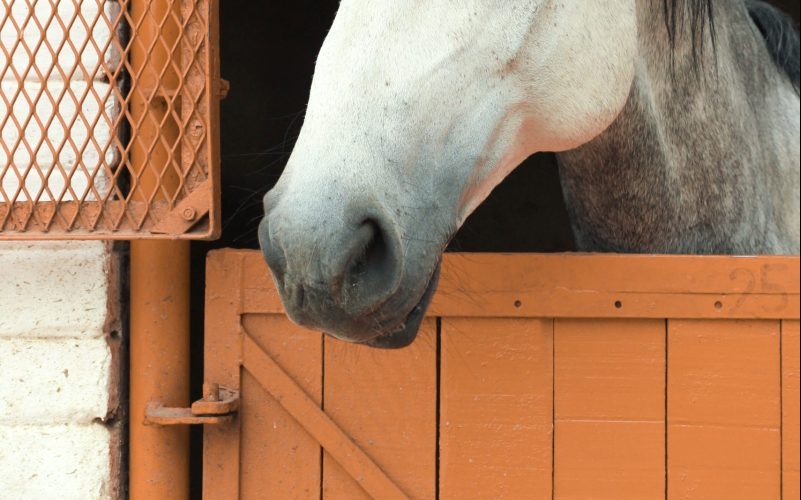If you show and haul frequently, you’re probably aware of the need to be cautious when introducing your horses to other equines due to the spread of infectious diseases. There are non-infectious respiratory diseases, though, that your horse can get from its environment whether or not it was exposed to another horse. The No. 1 non-infectious respiratory disease is equine asthma syndrome, which can present as mild-moderate or severe. If your horse develops either type, it’s going to affect the way it performs.
Quarter Horse News spoke with Dr. Steve Grubbs, DVM, PhD, DACVIM, Technical Services Veterinarian at Boehringer Ingelheim, to learn more about what causes equine asthma, how it affects your performance horse and ways to alleviate its effects.
Environment is Key
The most common cause of equine asthma, which is an inflammatory condition in response to triggers in the environment, is dust. Horses are exposed to dust in their everyday lives: it’s in their bedding, hay and even feed. For performance horses, it doesn’t end there — you can often watch sand and dirt blow in arenas, and even turn-out pastures aren’t immune.
Young competition horses that are housed indoors with little to no turnout make up a large number of horses with mild-moderate asthma, though older performance horses can be affected, too. And, it’s not just the Western industry that is afflicted. Due to the structures Thoroughbred racehorses are typically stabled in, which house many stalls and generate lots of dust because of the large amounts of bedding being used and hay being fed, it has been reported that up to 80% of those horses have mild-moderate asthma.
“Our sport horses are probably somewhere between 14-80%, and that’s due to housing,” Grubbs said. “They’re probably not housed in those big shed rows like the Thoroughbreds, but they’re still housed multiple horses per barn. There might be some turnout, but most of them are kept inside, and hay is often fed in racks above, so the dust is coming right to their face. So, it’s important to consider the environment.”
Severe Asthma = “Heaves”
Equine asthma syndrome has gone by several names over the years. Many horsemen know the old term for severe equine asthma: “heaves.”
In addition to being triggered by dust, heaves often has a hereditary component, too. If one parent is affected, it can predispose the offspring to developing asthma especially when living in dusty surroundings. Conversely, mild-moderate asthma can affect any horse, and there is currently no research showing it will develop into heaves.

“It’s been estimated anywhere from 12-14% of horses will have severe asthma,” Grubbs said. “The common onset is seven years of age or later, and once you have severe asthma, you always have it for life.”
Underperformance Can Be a Sign
Horses will not be able to perform at their peak during an asthmatic episode. Asthma causes inflammation, excessive mucus and bronchoconstriction of the airway, which obstructs the air moving in and out of the lungs. Depending on how severe it is, a horse might seem fine at rest but cough at the beginning of exercise, or it could display labored breathing while simply standing in its stall.
Sometimes, the only thing a rider will notice is the horse takes longer to recover after a workout.
“They’re not pulling in as much air, and they’re not getting rid of carbon dioxide — they’re not making that swap in their lungs because they can’t push the volume that they normally need because the airways are constricted, and then they also have mucus in them,” Grubbs said. “They need to do that to be able to feed those muscles oxygen and clear those muscles of waste, but the oxygen intake is depressed in some manner to where it affects performance.”
Since it’s not always clear an underperforming horse is suffering from respiratory issues, any changes should be investigated by a veterinarian.
A Clean Barn is a Healthy Barn
According to Grubbs, the best way to prevent a horse from developing asthma is to keep your barn as clean and ventilated as possible.
“The old saying is, ‘If we don’t change the environment, we’ll probably never treat our way out of the problem,’” Grubbs said. “It will come right back with the inciting cause or the trigger. To me, it’s finding what the little things are that can make a huge difference in that environment without rebuilding the barn.”
Minimize dust by using a broom to regularly knock down cobwebs and dirt on the ceiling and upper walls; feed hay on the ground; and when using a leaf blower to blow particles out of aisles, be sure to take the horses outside before stirring up the dust, and don’t bring them back in until it has settled.

Soaking hay can knock down the dust horses are exposed to when eating. You can also use low-dust bedding and change it when the horses are outside — additionally, a light spray of water over the top of the bedding will help keep the dust on the ground, rather than in the air. Finally, some horses with severe asthma might do better on pelleted or cubed diets, which tend to be less dusty than grain and hay.
Pharmaceuticals Can Help
If simple management of your horse’s environment isn’t enough to treat his asthma, there are pharmaceutical options to try. The first Grubbs reaches for are glucocorticoids or corticosteroids, which can temporarily reduce inflammation. From there he turns to bronchodilators, which widen the airways to help remove mucus. Since these tend to be short-term solutions, though, Grubbs stresses management changes first and foremost.
“The environment is, to me, the most important because we’ll do that all the time,” Grubbs said. “The other pharmaceutical products are there to get us through an episode or to manage it, but if we can make long-term, continuous changes in the environment, that is always the main goal.”


